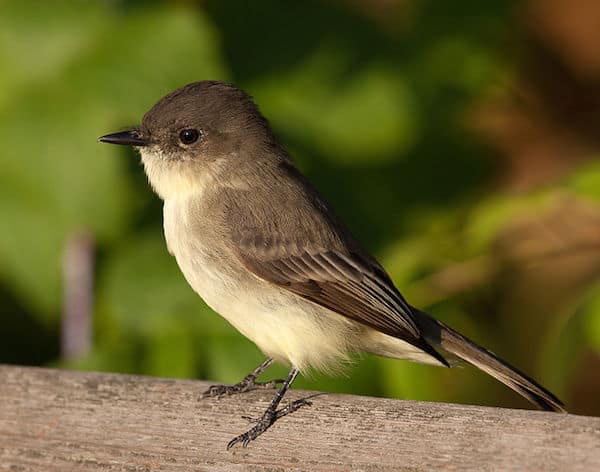Spring Birds of Michigan (March, April, May)
March is perhaps the most variable month weather-wise, sometimes being an extension of winter, sometimes heralding the beginning of spring, and usually exhibiting characteristics of both seasons. The arrival of male red-winged blackbirds by the first week in March, when they begin defending territories, filling the still brown marshes with their first song in months, could perhaps be considered a harbinger of spring. But, with the possibility for winterlike weather the entire month even in the southern portions, can this really be called spring? The traditional harbinger of spring, the American robin, is also Michigan’s state bird. But each year robins overwinter, sometimes quite far north, and in the south sometimes in flocks of hundreds, or thousands.
In contrast, while some birds are tentatively arriving in the southern portions of the state, including an incursion of migrant waterfowl following the ice breakup on the Great Lakes, the north is still firmly in the grip of winter, with some northward movement of northern finches and some raptors. This is a good time to check southern Lake Michigan, Lake Erie, and the Detroit River as thousands of waterfowl can suddenly appear after the ice breakup.
Yet other birds, including great blue heron, great horned owl, red-tailed hawk, mourning dove, gray jay, and horned lark, have actually begun nesting early in March. Toward the end of the month, American woodcocks arrive in the south and begin their courtship flights, and tufted titmice begin breeding. After the Vernal Equinox, the official beginning of spring in late March, the pace of arriving migrants increases with tree swallows, killdeer, Wilson’s snipe, rusty blackbird, and sometimes eastern phoebe typically arriving in the southern regions of the state.
April sees a noticeable increase in migrant arrivals, with many sparrows, kinglets, blue-gray gnatcatchers, and yellow-rumped warblers typically arriving mid-month. This is a good time for loon migration on the Great Lakes, and in the Upper Peninsula the duck migration is in full swing. Spruce and sharp-tailed grouse breeding activity is at its peak this month, making them somewhat easier to see than most other times of the year.
Spring raptor migration reaches its peak in the latter half of the month, with rough-legged hawks passing through sites like Whitefish Point in the Upper Peninsula and broad-winged hawks arriving in the Lower Peninsula. The first few shorebirds arrive at the end of the month, as well as the first scouts of the warblers, thrushes, and ruby-throated hummingbirds. April 15th is a good day to put up your hummingbird feeder in southern Michigan, as the first arrivals are often on or before this date. American tree sparrows, which have been resident all winter, usually depart for their more northerly breeding range by the end of the month.
Least flycatchers sometimes move into the state during the last week of April. This is a good time of year to visit wetland areas and shores of the Great Lakes for migrating waterfowl, loons, and grebes. Although woodland areas are still not leafed out, the forest floor blooms in profusion with spring ephemeral wildflowers including bloodroot, spring beauty, hepaticas, Dutchman’s breeches, common toothwort, spring cress, red trillium, and large white trillium.
May is the peak of migration throughout the state, with greatest numbers of some species occurring in the southern part of the Lower Peninsula as much as one or two weeks earlier than in the northern Lower Peninsula and the Upper Peninsula. Warblers and thrushes begin to arrive the first week, and most reach their peak mid-month. Cool mornings early in the month will often find Baltimore orioles visiting your hummingbird feeders, so it’s a good idea to give them a separate feeder and some orange halves before the first of May. Kirtland’s warblers arrive on average around May 10 and begin singing actively by about May 15.
Flycatchers and cuckoos arrive later in the month, along with some of the later arriving warblers, particularly Connecticut warbler. Loons and waterfowl continue to migrate along the Great Lakes, especially in the Upper Peninsula. Shorebird numbers build up, at least where there is habitat, through the end of the month. Whimbrels make a fleeting appearance statewide in a narrow window centered on May 25, but most other shorebird species have mostly departed by the end of the month.
Weather affects the number of migrants, especially nocturnal migrants, which will be detected in any given spring. If weather conditions are favorable for migration, that is south winds overnight with fair weather and clear nighttime skies, many migrants will over-fly much of the region and arrive safely on their breeding grounds. Bird watchers often consider this situation to be a poor spring migration, but it is certainly the best situation for the birds.
More often, spring storms move through Michigan, with heavy rain, sometimes strong north winds, with cool temperatures following. Migrants encountering these conditions at night are grounded, where they must find shelter and food to wait out the passage of these weather systems. Under these conditions, bird watchers may find birds nearly everywhere in the morning, and often feeding very near the ground as most insect activity will also be depressed in cooler conditions. This is known as a “fallout” of migrants, and is something that Michigan bird watchers look forward to each spring, keeping a vigilant eye on the weather reports through the month of May.
While allowing bird watchers excellent opportunities to observe many colorful migrants at close range in almost any habitat, including urban parks and suburban backyards. Such fallouts are stressful to the migrant birds and, if conditions are severe enough, can prove fatal for some. However, migrant birds have been encountering the hazard of weather systems during their migrations for eons with little impact on their populations. Loss of habitat and collisions with human-made structures are newer hazards that the birds haven’t adapted to, and these cause far greater mortality than natural forces.




